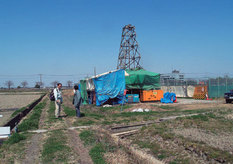Bulletin of the Geological Survey of Japan Top Page
Bulletin of the Geological Survey of Japan Vol.60 No.3/4 (2009)
Cover photograph | Table of Contents | Abstract
Cover photograph

Drilling site of GS-SB-1 core
A boring core 350m in length (GS-SB-1) was obtained from Shobu town, Saitama Prefecture, central Kanto Plain. This photograph shows a drilling site of the core. Subsurface investigation using boring cores and boreholes plays an important role in understanding geologic stratigraphy and structure of Quaternary basins such as Kanto Plain. Comprehensive investigation including lithofacies and tephra description, microfossil analyses, paleomagnetic measurement, physical property measurements, and well logs are performed on GS-SB-1 core and the borehole. See Yamaguchi et al. (2009), Ueki et al. (2009) and Naya et al. (2009) of this issue for current results of these investigations.
(caption: Tomonori Naya, photo: Masaaki Yamaguchi)
Table of Contents
| Title | Author | |
|---|---|---|
| Report | ||
| Lithofacies and physical properties of 350-m-long GS-SB-1 core, central Kanto plain, Japan. | Masaaki Yamaguchi, Kiyohide Mizuno, Tomonori Naya, Misao Hongo, Hiroomi Nakazato, and Tsutomu Nakazawa (147-197) | 60_03_01.pdf [11.1 MB] |
| Paleomagnetic and rock-magnetic measurements of the GS-SB-1 core at Shobu Town, central Kanto Plain, Japan. | Takeyuki Ueki, Masaaki Yamaguchi, Misao Hongo, Tomonori, Naya and Kiyohide Mizuno (199-243) | 60_03_02.pdf [6.4 MB] |
| Notes and Comments | ||
| Occurrence horizons of diatom fossils and recognition of marine sediments in the Shobu Core (GS-SB-1), Saitama Prefecture, central Kanto plain, Japan. | Tomonori Naya, Masaaki Yamaguchi and Kiyohide Mizuno (245-256) | 60_03_03.pdf [3.5 MB] |
Abstract
Lithofacies and physical properties of 350-m-long GS-SB-1 core, central Kanto plain, Japan.
Masaaki Yamaguchi, Kiyohide Mizuno, Tomonori Naya, Misao Hongo, Hiroomi Nakazato, and Tsutomu Nakazawa
A 350-m-long sediment core, the GS-SB-1, was recovered at Shobu Town, central Kanto plain. This core was obtained to achieve a standard stratigraphy of the Lower to Upper Pleistocene subsurface geology in the central Kanto plain. This paper describes basic lithofacies, tephras and physical properties of the GS-SB-1. Physical properties including density, elastic wave velocity, spontaneous potential, and electric resistivity were measured. Sixty-nine facies units (unit 1 to unit 69 in descending order) were identified and their relation to physical properties was discussed. Thirty-nine tephras were found from GS-SB-1 core, and two of them correlate to the Ontake Pm-1 tephra (9.90-10.90 m in depth, ca 100 ka), and the Ks5 tephra (182.85-182.87 m in depth). Stratigraphic boundary between the Shimosa Group and the Kazusa Group is situated between 165 m and 184 m in depth. Nine marine deposits were identifi ed based on sedimentary facies and diatom assemblages reported by Naya et al. (2009).
Paleomagnetic and rock-magnetic measurements of the GS-SB-1 core at Shobu Town, central Kanto Plain, Japan.
Takeyuki Ueki, Masaaki Yamaguchi, Misao Hongo, Tomonori, Naya and Kiyohide Mizuno
Paleomagnetic and rock-magnetic measurements were performed on the GS-SB-1 core of 350.2 m long drilled at Shobu Town, Saitama Prefecture, central Kanto Plain, Japan. 493 and 16 samples were taken from the core for progressive alternating fi eld and thermal demagnetization experiments. Approximately 95 % of the samples have a stable remanent magnetization component. The core between 0 and 266.755 m in depth yielded a normal polarity, while between 276.9 and 350.2 m in depth was a reversed polarity. The reversal between 266.755 and 350.2 m in depth corresponds to the Matuyama-Brunhes polarity transition.
Occurrence horizons of diatom fossils and recognition of marine sediments in the Shobu Core (GS-SB-1), Saitama Prefecture, central Kanto plain, Japan.
Tomonori Naya, Masaaki Yamaguchi and Kiyohide Mizuno
Diatom fossils were examined in order to recognize marine and freshwater sediments in the Shobu core (GS-SB-1), central Kanto plain, Japan. Diatom fossils occur in 174 samples of 306 investigated samples. Fresh water diatoms and brackish and/or marine diatoms occur in 159 samples and 44 samples, respectively. As a result, nine marine intervals were recognized at following depth of the GS-SB-1 core; 27.625 - 32.875 m, 75.45 m, 114.375 - 118.375 m, 157.32 - 164.875 m, 216.6 - 219.3 m, 255.1 - 262.0 m, 273.72 - 276.3 m, 280.6 - 282.6 m and 314.4 - 319.25 m.
Geological Survey of Japan, AIST
- About GSJ
- Our Activities
- Purchase guide
-
Publications and Database
- information
- Bulletin of the Geological Survey of Japan
- bull2025(Vol.76)
- bull2024(Vol.75)
- bull2023(Vol.74)
- bull2022(Vol.73)
- bull2021(Vol.72)
- bull2020(Vol.71)
- bull2019(Vol.70)
- bull2018(Vol.69)
- bull2017(Vol.68)
- bull2016(Vol.67)
- bull2015(Vol.66)
- bull2014(Vol.65)
- bull2013(Vol.64)
- bull2012(Vol.63)
- bull2011(Vol.62)
- bull2010(Vol.61)
- bull2009(Vol.60)
- bull2008(Vol.59)
- bull2007(Vol.58)
- bull2006(Vol.57)
- bull2005(Vol.56)
- bull2004(Vol.55)
- bull2003(Vol.54)
- bull2002(Vol.53)
- bull2001(Vol.52)
- Bulletin of the Geological Survey of Japan(old)
- Annual Report on Active Fault and Paleoearthquake Researches
- Reports, Geological Survey of Japan
- CCOP-GSJ Groundwater Project Report
- CCOP Technical Bulletin
- Cruise Report
- Geological Hazards
- Learning and Education
- GSJ Database Collection
- Collection of links

